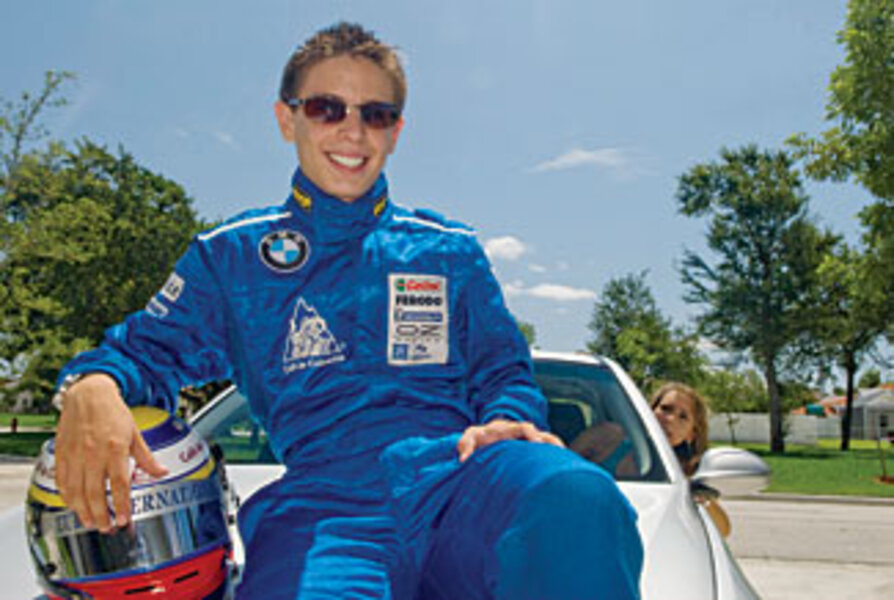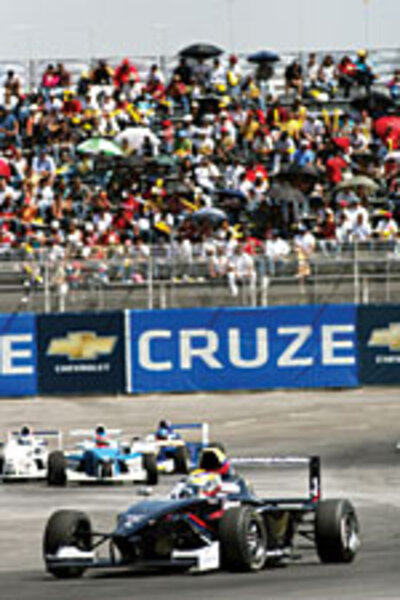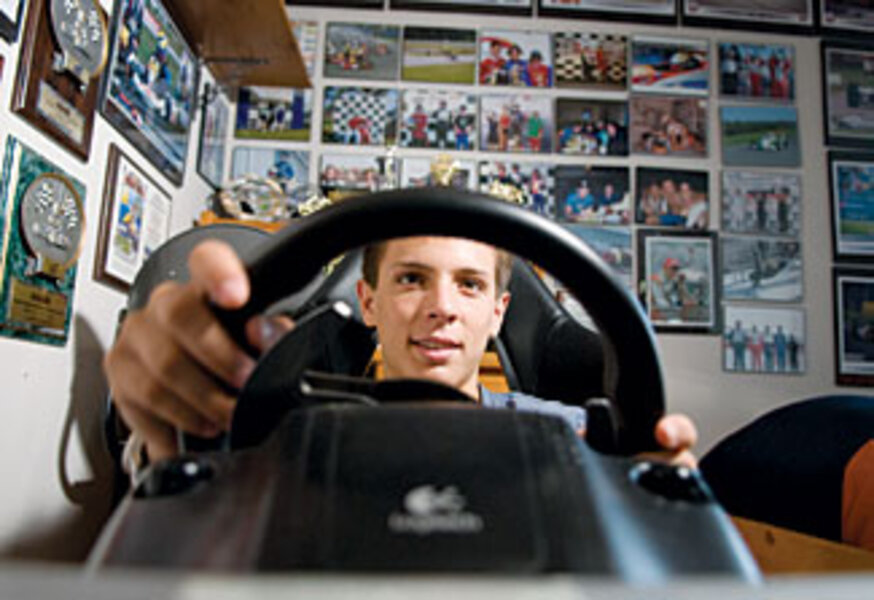Teenage sensation emerges on the race track
Loading...
| weston, fla.
Inside the race car simulator on his bedroom floor, 15-year-old Gabby Chaves takes on the road. Trees rush by. The wheel shimmies. Dodging other vehicles and negotiating corners that come impossibly fast, Gabby is the essence of concentration.
Gone are the banter and easy smile evidenced earlier as he downed an after-school snack of chicken with rice. Instead there are laserlike intensity and reflexes so fast you can't follow the motion of his hand from steering wheel to gearshift.
But what happens in the simulator is nothing compared with what goes on inside his formula race car, at speeds as high as 150 m.p.h. There, gravity is tripled and the effort of keeping his car on the track makes Gabby's shoulders ache.
He's up for it. Currently in second place in the Formula BMW Americas series, Gabby is the youngest driver ever to win a Formula BMW race. He was the undefeated champion of the 2007-08 Skip Barber Southern Regional Series and has raced vehicles throughout North America and in Asia, Europe, and South America.
Formula 1 TV commentator Peter Windsor, who co-owns the nascent US-based Formula 1 team, puts Gabby on a "shortlist of guys we are looking at" as drivers. Noting Gabby's BMW wins, Mr. Windsor calls him "very young and very talented."
Others concur. "Gabby has the qualities to be the best driver in the world," says Daniel Villa, Gabby's longtime coach and adviser, who accompanies him to races. "Natural speed, unbelievable focus, and precision. And he's really smart, on and off the track."
Underpinning all this is Gabby's nature. Earlier, as he was working his way through the plate of chicken in the family's great room, his mother, Pilar, looked on. "Even when he was small he was like a little man," she said. "Very centered. Calm and quiet." Gabby's father, Gabriel, a pilot for Jet Blue, leaned in to comment. "Good mental discipline," he said.
Gabby shrugged at their descriptions. "That's how they see me." He lifted the family's Shih Tzu, FedEx, onto his lap and scratched beneath its chin. "I'm like that when it's necessary," he said. "But when it's time to be outgoing and have fun, I can do that, too."
For starters there's his girlfriend, Juanita, whose touches can be found in Gabby's trophy-laden bedroom – a stuffed bear and a pillow inscribed, "I love you." "Anything that seems out of the ordinary for a boy – that's from Juanis," Gabby says, clearly pleased by the evidence of her affection.
He acknowledged possibly being more mature than the average 15-year-old. It's the driving, he says. "Kids, you know, are always trying to be tough. I was that way, too, before I started racing. Then I realized it made no sense. There's no need to prove yourself."
Not that he doesn't still have boy in him. "The fun part of racing is the speed," he says. "That's something every kid wants. I'm the lucky one who gets to have it." Then there's the physicality. "Racing is supposedly a noncontact sport. It's not that you want to bump someone and get him out of the way. But sometimes you're racing side by side and there's just no room."
HIS CAREER BEGAN during a summer trip to his family's native Colombia when Gabby was 11. One day his grandfather brought him to the local go-kart track. A single loop around the circuit was all it took. "Even though it was all new to me, I just felt it right away. The atmosphere, the particular smell of gasoline and tires – I loved it."
Driving fast seems to be in his genes. Pilar competed in the Sprint Cup Series in the 1990s, dropping out after she learned she was pregnant with Gabby. And the grandfather who introduced him to go-karts, a man Gabby counts among his foremost fans, also raced, as did an uncle.
That summer in Colombia, Gabby went to the track seven days in a row. Already a serious tennis player who ranked among the top five in his age group in Florida, he was also drawn to the competitive aspect of karting. Back at home in the US, he began entering races under the instruction of Mr. Villa, who had been on the Sprint circuit with Pilar in Colombia.
Soon Gabby was winning almost everything he entered. In 2005, he was the Easykart 60 cc US Grand National Champion, which earned him an expenses-paid trip to the world finals in Italy. He went on to the 2006 championships in the Rotax East Coast Division and the cadet class Stars of Karting Nationals.
At 13, he won the 2006 Skip Barber Karting Scholarship Shoot-out, the largest and most important event for karters transitioning to race cars. As a Barber star, Gabby joined the ranks of other racing luminaries such as Jeff Gordon and Michael Andretti.
Eighteen months ago, around the time he got the braces off his teeth, Gabby started driving open wheel, which generally refers to Indy-style single-seat cars with wheels outside the main body. It wasn't long before he was winning those races, too.
Still, the shift from a 100 cc engine to a 2000 cc one was dramatic, both in terms of the speed (nearly tripled) and power. "My arms hurt. I was totally out of breath. It was really, really hard," he says of those initial races.
Gabby likens the workout of driving open wheel to that of a cyclist peddling 22 m.p.h. The road grip of the car intensifies the effects of gravity, pushing his body against the seat or the door, and there's no power steering or power brakes. "It's all the time a mixture of never-ending forces," he says. "It's unbelievable."
To deal with the physical demands, Gabby works to stay healthy. He avoids junk food, packing lunches to bring with him to school. He also runs almost every day on trails near Weston while listening to trance and techno music on his iPod. Often he and Juanita run together. The running, along with hours of practice each week in the simulator, prepares Gabby for races, which occur about 10 times a year. Typically he only gets into an actual race car on location the week of the event.
HIS CURRENT VEHICLE is a Formula BMW: 1,000 pounds, seven-speed sequential transmission, 0 to 60 m.p.h. in 3.5 seconds. The $500,000 annual cost to keep him on the circuit is absorbed by his corporate sponsor, Café de Colombia, his family, and his agent. The Chaveses are always looking for new sponsors. Indeed, Pilar thought FedEx's name a little silly until it occurred to her that the company might consider helping to keep Gabby on the track. (So far no luck.)
Apart from minor injuries he received in a go-kart incident, Gabby has not had any accidents while racing. He does not think about the risk, he says, nor is he afraid.
"Everything is engineered to keep the driver safe," he says. "The car, the suit, the helmet, the HANS [a device that stabilizes the driver's neck]. Everything." Pilar nods assent. Any anxiety she feels for her son before a race is a function of the competition rather than of the danger, she says.
Gabby is more interested in talking about the metaphysics of the driving experience, which he calls "intense." "When you're in the toughest of situations, competing for a very small margin of time, sometimes you're able to make a connection, to become one with the car. Everything happens in slow motion."
The experience, he says, is similar to one noted by his hero and role model, Ayrton Senna, a Brazilian driver who described a sense, while driving, of leaving the car and watching himself from above. Gabby's green eyes widen as he talks about the psychic impacts of racing: "This is something very spiritual."
He much prefers race car driving to competitive tennis. "In tennis, you're completely on your own," he says. "In driving, it's a team effort. You work with the engineers and the mechanics. You always have someone in your earphones." About 20 people support the Formula BMW Americas team of four drivers.
Gabby's next race is in July. Until then, there's school, Juanita, running, and daily practice on the simulator. And interviews, as Gabby's celebrity continues to rise.
"Time to get ready!" his mother calls from the kitchen. Gabby turns off the simulator. He's off to a Spanish-language TV station in Hialeah, Fla. He'll tape a live interview, and his mom and Juanita will be part of the audience. The producers want him to appear in racing gear.
Gabby gathers his suit, helmet, HANS device. He piles books into a backpack. On the way home, he'll do his biology homework.
In July, when he turns 16, Gabby intends to get his driver's license. Then he'll be able to drive himself wherever he needs to go. Will he tell the examiner that he's a race car driver who routinely drives at speeds of 120 m.p.h.?
"No way," he says. "They'd never pass me if they knew."








